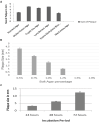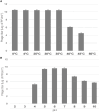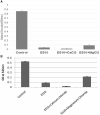Characterization of ES10 lytic bacteriophage isolated from hospital waste against multidrug-resistant uropathogenic E. coli
- PMID: 38525078
- PMCID: PMC10957765
- DOI: 10.3389/fmicb.2024.1320974
Characterization of ES10 lytic bacteriophage isolated from hospital waste against multidrug-resistant uropathogenic E. coli
Abstract
Escherichia coli is the major causative agent of urinary tract infections worldwide and the emergence of multi-drug resistant determinants among clinical isolates necessitates the development of novel therapeutic agents. Lytic bacteriophages efficiently kill specific bacteria and seems promising approach in controlling infections caused by multi-drug resistant pathogens. This study aimed the isolation and detailed characterization of lytic bacteriophage designated as ES10 capable of lysing multidrug-resistant uropathogenic E. coli. ES10 had icosahedral head and non-contractile tail and genome size was 48,315 base pairs long encoding 74 proteins. Antibiotics resistance, virulence and lysogenic cycle associated genes were not found in ES10 phage genome. Morphological and whole genome analysis of ES10 phage showed that ES10 is the member of Drexlerviridae. Latent time of ES10 was 30 min, burst size was 90, and optimal multiplicity of infection was 1. ES10 was stable in human blood and subsequently caused 99.34% reduction of host bacteria. Calcium chloride shortened the adsorption time and latency period of ES10 and significantly inhibited biofilm formation of host bacteria. ES10 caused 99.84% reduction of host bacteria from contaminated fomites. ES10 phage possesses potential to be utilized in standard phage therapy.
Keywords: E. coli; antibiotic resistance; bacteriophage; biofilm; phage therapy.
Copyright © 2024 Nawaz, Zafar, Alessa, Khalid, Shahzadi, Majid, Badshah, Shah and Khan.
Conflict of interest statement
The authors declare that the research was conducted in the absence of any commercial or financial relationships that could be construed as a potential conflict of interest.
Figures











Similar articles
-
Characterization and therapeutic potential of phage vB_Eco_ZCEC08 against multidrug-resistant uropathogenic Escherichia coli.BMC Microbiol. 2025 Apr 16;25(1):221. doi: 10.1186/s12866-025-03903-x. BMC Microbiol. 2025. PMID: 40240928 Free PMC article.
-
Isolation and Characterization of Novel Lytic Phages Infecting Multidrug-Resistant Escherichia coli.Microbiol Spectr. 2022 Feb 23;10(1):e0167821. doi: 10.1128/spectrum.01678-21. Epub 2022 Feb 16. Microbiol Spectr. 2022. PMID: 35171030 Free PMC article.
-
A lytic phage to control multidrug-resistant avian pathogenic Escherichia coli (APEC) infection.Front Cell Infect Microbiol. 2023 Sep 7;13:1253815. doi: 10.3389/fcimb.2023.1253815. eCollection 2023. Front Cell Infect Microbiol. 2023. PMID: 37743864 Free PMC article.
-
Characterization of novel bacteriophage phiC119 capable of lysing multidrug-resistant Shiga toxin-producing Escherichia coli O157:H7.PeerJ. 2016 Sep 13;4:e2423. doi: 10.7717/peerj.2423. eCollection 2016. PeerJ. 2016. PMID: 27672499 Free PMC article.
-
Bacteriophage therapy for inhibition of multi drug-resistant uropathogenic bacteria: a narrative review.Ann Clin Microbiol Antimicrob. 2021 Apr 26;20(1):30. doi: 10.1186/s12941-021-00433-y. Ann Clin Microbiol Antimicrob. 2021. PMID: 33902597 Free PMC article. Review.
Cited by
-
Genome sequencing of Escherichia coli phage UFJF_EcSW4 reveals a novel lytic Kayfunavirus species.3 Biotech. 2025 Jan;15(1):10. doi: 10.1007/s13205-024-04172-7. Epub 2024 Dec 15. 3 Biotech. 2025. PMID: 39691801
References
LinkOut - more resources
Full Text Sources

